
15 Tips for RVing with a Baby
15 Tips for RVing with a Baby
How to prepare for a successful RV trip as new parents.
By: Heath & Alyssa Padgett
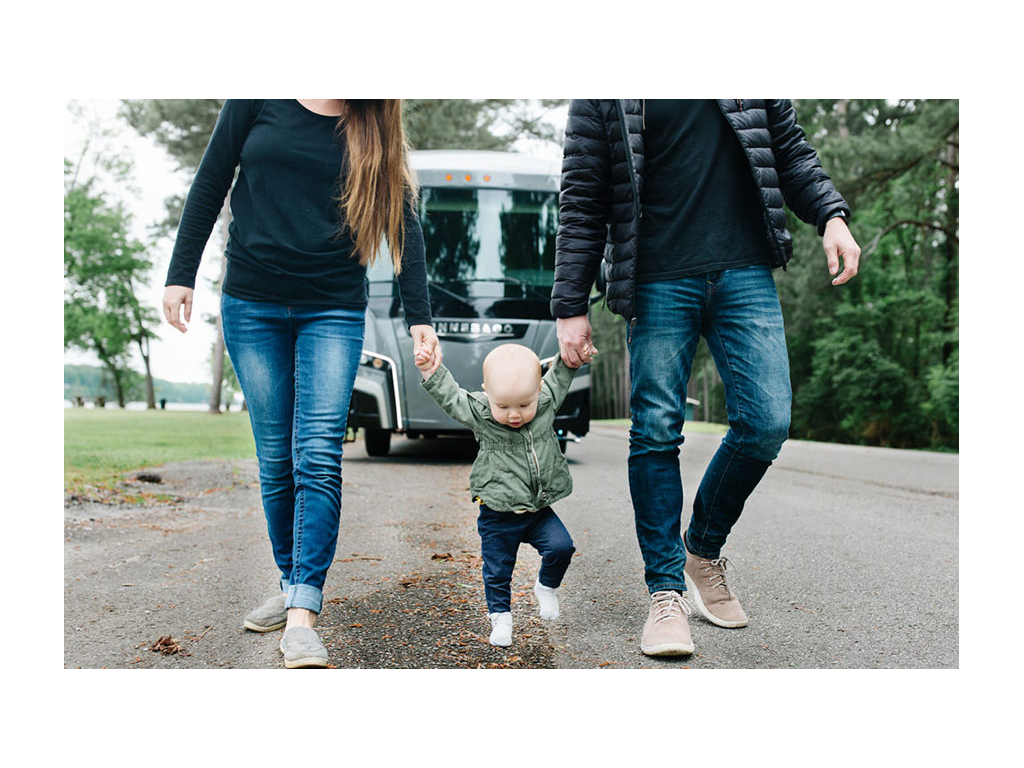
When we first moved into an RV at age 23, people incessantly asked us if we would have kids while we traveled the country, which I thought was a bit much considering we started RVing four days after our wedding.
We always said we didn’t know — kids were so far away!
The month before our daughter was born, we took one final trip to a beachfront campground in Galveston. Waddling around the RV park and down the beach, I knew for sure that we needed to keep traveling with Ellie. After five years of RVing everywhere, it was in our blood!
Right now, we’re camping at 10,000 feet in the mountains of Colorado and Ellie has spent most of her life on wheels. She’s visited 13 states, stamped her passport in Paris, and slept in her first motorhome in Venice, Italy.
We’ve learned so much about traveling with a baby this past year — both good and bad — and today I’m sharing some of the biggest tips I’ve learned from fellow moms and personal experience RVing with a baby.
Before You Hit the Road...
1. Find an RV that can secure a car seat.
Keeping a baby safe while traveling in an RV is a huge concern for many parents — especially if you plan on traveling in a motorhome. This is less of an issue if you’re towing a trailer and you can safely latch your car seat into your vehicle.
But motorhomes may not necessarily have forward-facing seats or a LATCH system. This is something to consider before you buy or rent an RV. You’ll want to find a motorhome with a dinette booth that has LATCH or additional anchors installed. In order to secure our car seat into our dinette booth, we lower the table into the bed position because our bulky car seat barely doesn’t fit with the table up. The lowered area is also a great place to store a toy bin or snacks for the drive, so they are easily in arm’s reach.
Oh, and make sure you don’t open any of the cabinets above the car seat while your kid is still strapped in. They may end up with a box of cereal in their lap. (Clearly not talking from experience here…)
The other big consideration when choosing an RV is where the baby will sleep. You can find many RVs with bunk floorplans (you may just want to buy or build out additional railing!) to give your little one their own space. You can also travel with a baby bed like we do, which I’ll talk more about in a second!
When we caravanned in Italy, we carved out a place for Ellie to sleep in a 24-foot RV, so don’t think you have to get something huge just because you have a new addition! We chose the 40’ Forza here in the states because we are full-time and it offers plenty of room for Ellie, plus an office for Heath and I.
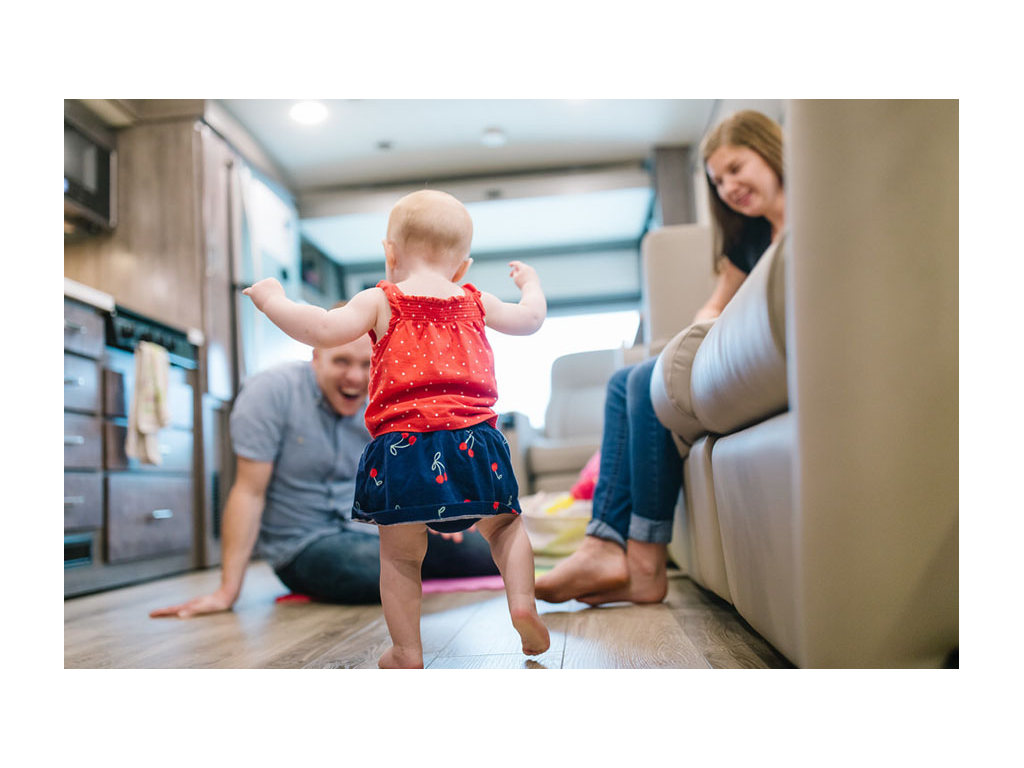
2. Consider the weather.
When we headed out west for the mountains, it was 100 degrees in Texas. And in almost any RV it can be a challenge for the A/C to keep the whole house cool.
Weather is one of the biggest considerations we make when planning our travels. The temperature of an RV is greatly affected by heat and cold and if you’re boondocking (camping without hookups) or spending long days driving, extreme temperatures can make camping unbearable or unsafe.
Our first time to boondock in our Forza, it was early in January and we were in Florida. We were sweating like crazy! Because, well, Florida. We didn’t even think we needed to worry about overheating in the RV in the winter, but it was immediately obvious that the temperatures required us to crank on our generator to use the A/C or find an RV park with hookups. (Thanks for the 90 degrees in January, Tampa).
Especially during winter or summer trips, you’ll want to take weather into consideration as you choose your destination(s).
(Here’s a fun blog post to help you plan where to camp to always experience 70º days! Fellow contributors the Bajuelos have more tips as well, here.)
However, sometimes your destination may be perfect weather (high of 72º in Colorado today) but you have to drive through extreme temps to get there. When we drove across the plains of West Texas, we cranked on our generator to power the two A/C units in our RV and keep it cool.
On the other hand, when we drove across Iowa and Nebraska in December, the outdoor temps were in the teens! When it was sunny, we opened all the window shades so the light could stream in. When it was cloudy, we closed the shades to keep out the cold. To generate more warmth inside, we cranked on the generator and used our electric fireplace while driving. Whenever we stopped for lunch or diaper changers, we turned the furnace on high to help warm up the rig as well. (NOTE: You should not use your furnace as a heating option while driving as using propane while in motion is a fire risk).
If you travel with a towable, when you arrive at your destination, you may find the RV to be extremely cold or extremely hot as well. You can change the temperature in your rig faster by turning on your A/C unit(s) with the slides in, requesting campsites in the shade, and avoiding cooking or using heated appliances for the first hour you’re in the rig.
3. Plan your route carefully.
Before our daughter was born, we were fearless drivers. Take the scenic route? Sure. Bumpy mountain road? Absolutely! Interstate? No, thank you.
But now that we have a little life to care for, we have a few new priorities like making sure we have cell signal while we are driving and wherever we are camping. That way, if we get in an accident or need help, we have the connection we need. We use Campendium.com to check the cell signal at our destination and, in our experience, most interstates have coverage.
4. Choose foldable, stowable, durable gear.
Babies may be tiny, but it is true that they need quite a few things, especially when traveling.
You may want (if not need) a:
- High chair
- Stroller
- Pack and play or travel bed for co-sleeping
- Body carrier
- Baby bath
- And car seat
We’ve chosen gear that’s easily stowed when not in use, like this foldable high chair: We’ve used it for eight months and it’s been perfect for meal time.
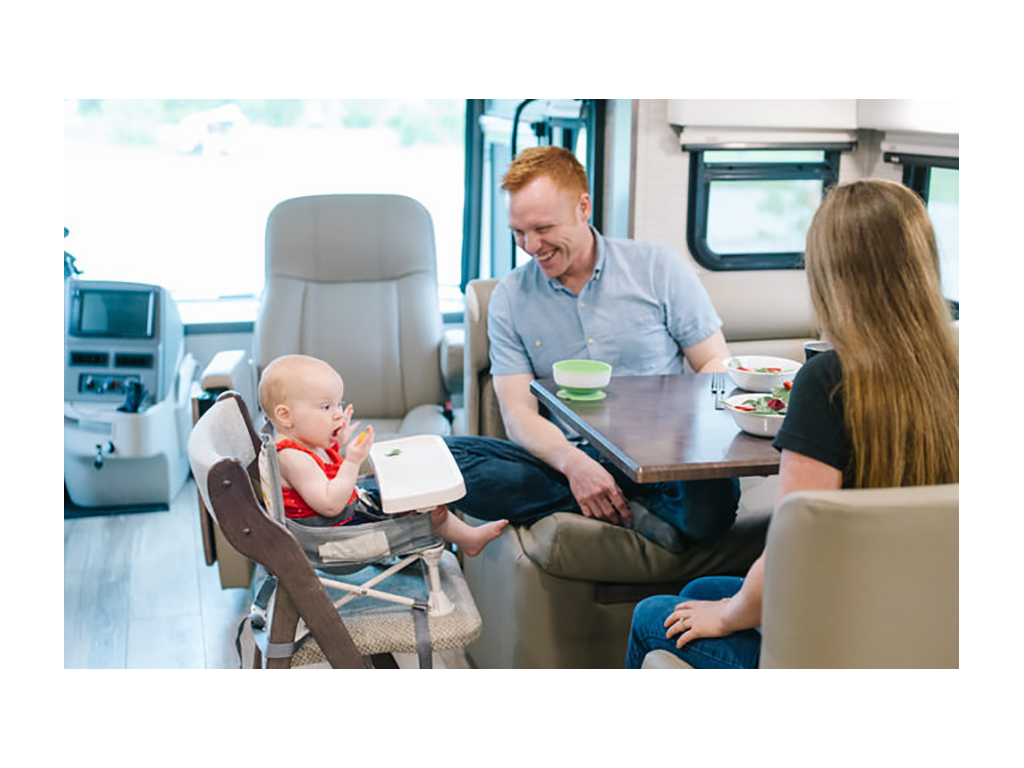
For sleeping, we don’t have an RV with a bunk floor plan, which most couples traveling with kids choose. (Technically our desk can turn into a bunk, but we keep it as an office!) So, we travel with a pack and play and set it up in our bedroom or in our bathroom:
We’ve also used this smaller travel bed before Ellie could roll over.
For adventures, we travel with a travel system stroller (you know, the fancy kind of stroller where the car seat snaps into the stroller for easy travel!) and a body carrier. This is our favorite carrier we’ve used because it’s super durable, machine washable, and Ellie has been in it for over a year. (Plus, it’s less than $30 and can fit in a diaper bag.)
There isn’t much room in an RV for bulky baby gear, but we do travel with an infant-toddler bathtub and as full-timers, I’m so glad we do! Ellie loves bath time and showering with a one year old gets old FAST.
If you don’t want to bring a big tub along, you can pick up an inflatable baby bath at any Walmart.
5. Know when you can safely travel.
After four weeks of being stuck inside because of the summer heat, we decided to take a road trip up to Colorado with our newborn baby. After all, our doctors encouraged us to travel with Ellie and we’d been stuck in one place for 10 weeks at that point (oh yes, I was counting).
We drove to southern Colorado from North Texas in one day and Ellie was a champ, sleeping all day like four-week-old babies do. As we were falling asleep that night, Heath casually told me to drink extra water since we were at elevation.
Then it hit me. Holy crap, we were 7,000 feet high with a newborn baby! Is that okay?
I did what every parent knows they shouldn’t do: I consulted Doctor Google.
Doctors tell new parents to never do this because you’ll convince yourself that your baby’s cough means she’s dying of cancer or whooping cough or COVID or maybe she just had milk in her throat and needed to cough it out, but it’s probably incredibly life threatening, might as well call the doctor in tears.
But in this case Google said one thing, in every single article, on the first three pages of results:
Do not take a baby under three months to elevation as the lungs are not fully formed yet*.
(*Unless they are born at elevation as these babies have time to adjust while still inside their mom.)
So here I am, hours from sea level, it’s pitch black outside, we’re in our pajamas, and we are 7,000 feet high. And I can’t sleep now! I might be accidentally suffocating my child! I am the worst mom of all time!
After the longest night of my life, we wait until 8:00 AM central time and call our doctor who tells us that she might be fussy, have trouble sleeping, and need extra milk, but she will be fine. Watch her on the mountain passes as her ears might pop and bother her.
Ellie was completely fine the whole trip, crying once in her sleep when we topped 10K crossing Monarch Pass, and Heath and I successfully completed our first road trip with an infant.
So while you can travel with your baby as soon as you feel comfortable, you might want to avoid higher elevations for the first couple of months, unless your baby was born at altitude (and either way, it’s a good idea to consult your doctor).
6. Make note of local hospitals and urgent care clinics.
Speaking of medical scares, it’s always a good idea to find local hospitals and urgent care clinics just in case. You can easily search for these in Google Maps on your computer or phone and then click the save icon. This will make it easier for you to find later, if you need it.
RV parks or campgrounds will likely also have this information on hand when you arrive at your destination.
If you need 911, you’ll want to have your RV park address or GPS coordinates (if you’re boondocking, for example) handy as well. You can save these in your Google Maps for easy reference.
7. Pack light
On a daily basis, my daughter plays with:
- My sunglasses
- Keys
- Spatulas
- Stainless steel bowls which are VERY loud when thrown across the RV
- Her books
And ignores her bin of toys for most of the day. Which is why if you’re not full-timing like us, I would skip bringing many toys at all! Especially for younger babies who haven’t quite grasped how toys work at all.
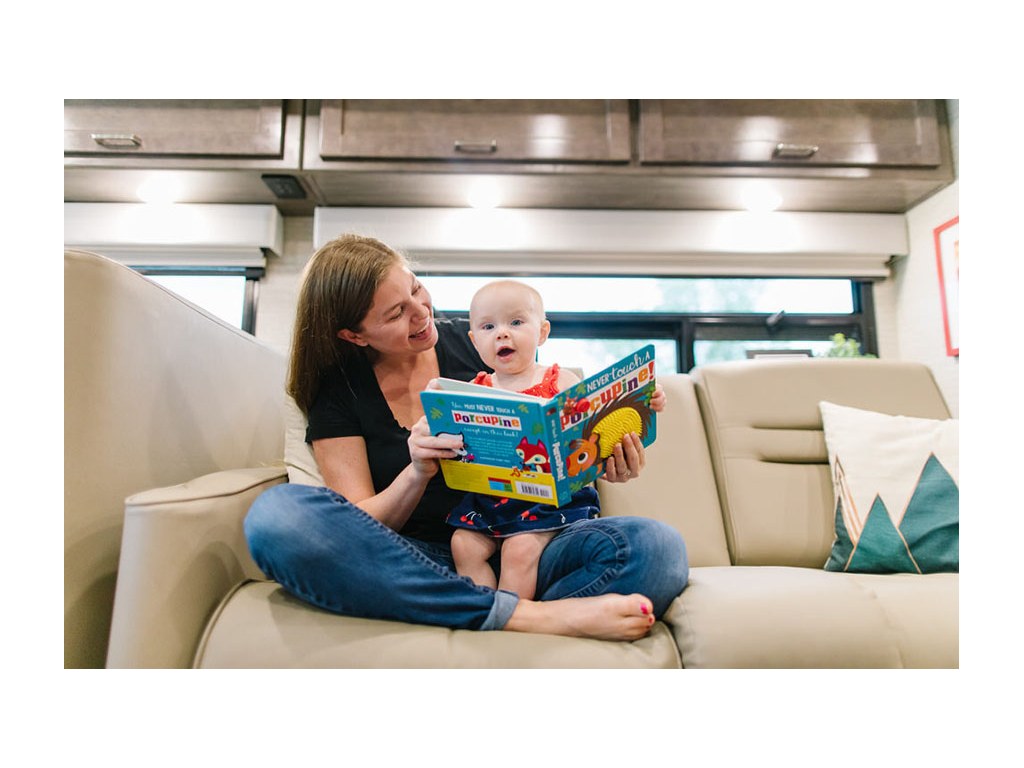
We do have some hanging toys attached to the car seat for entertainment while driving and we keep a bin of board books handy. But most of Ellie’s toys are in a box in one of our storage bays because all she does is throw them on the floor, pick up her toy bin, and walk around wearing it like a hat.
On the Road...
8. Naps take the highest priority.
Depending on how young your baby is, you may not have a nap schedule.
Our daughter was four months old when we flew to Italy and rented a motorhome to explore the country. I purposefully decided to hold off on creating any sort of daily schedule for Ellie so that she would be happy on the go while we explored Italy and ate our weight in pizza.
This was great because she learned how to nap in her carrier, fall asleep amidst the chaos of travel, and we could keep on exploring. Other than needing to be home and in bed before eight, we could take her everywhere and never worry about rushing back to the RV for naptime.
But because we didn’t keep her on a schedule, we sometimes timed things really poorly. She would nap during our hike and then be wide awake and crying in her car seat while Heath is driving a manual transmission motorhome down a road built for horse carriages.
Not the best scenario.
It only took a few days of making that mistake before we learned to time driving with nap time! Now that Ellie is walking, this is 100X more important. She loves to move and spending five hours straight in a car seat isn’t great for any of us. We plan all our travel days around her naptime (which is right after lunch) to make driving easy for all of us.
(Read more tips for RV travel days with kids here).
9. Figure out what your “big guns” are.
Speaking of getting a baby to nap, sometimes you need to “bring out the big guns,” as they say.
Because babies cry. Loudly. And typically, right in your ear.
So, whether they are tired, hungry, or just throwing a tantrum, you’ll know whatever it is that works every time.
Every baby is different. Maybe you need to sing a lullaby (If you’re happy and you know it is a true crowd-pleaser) or keep a certain toy with you at all times.
For Ellie, La Vie En Rose by Louis Armstrong calms her down like magic. Two rounds and she’s asleep. I don’t know where she got her love of jazz, but it’s my favorite song now too. And if it isn’t naptime, if I count to ten slowly, she LOVES it. (She’s a weird kid, what can I say?)
Whatever your big guns are, keep it in your pocket so you’re ready for that next freak out.
10. Keep milk and snacks handy.
If you’re nursing, this makes travel so much easier. I’ve fed Ellie in the backseat on the side of so many highways! And once she learned how to burp on her own, I learned how to nurse her without getting her out of the car seat, so Heath could keep motoring on. (It’s kinda like a super uncomfortable yoga pose that ends with a happy baby).
When we moved into our Forza in December, we brought six months of frozen breastmilk with us. (Yeah, we couldn’t buy frozen food for a while there, but it is so worth it!) This is a huge perk to RV travel over planes or cruises because I can have milk and snacks straight from our kitchen with us at all times.
In the car, we keep our diaper bag stocked with baby food and milk. We use a small lunch box that packs away easily if we need to keep milk or food on ice. And after doing all that, we quickly learned to keep a roll of paper towels in the car too. Smoothies have been flung all over that backseat!
11. Wear your baby.
Until Ellie was here, I never realized how inaccessible so many sidewalks, trails, and campgrounds are. Have you ever tried to push a stroller through gravel? It’s impossible!
Which is why we bring our body carrier with us at all times, for exploring downtown, hiking, or taking walks on the beach. It’s so much easier to navigate, plus babies are generally happier when they can be closer to their parents.
And bonus, it makes losing pregnancy weight so much easier!
12. Go out early.
If you’re meeting up with friends or wanting to go out to dinner during your travels, the trick is to go early.
I’m talking like 5:30 PM or before.
Restaurants are less crowded at this time (AKA way fewer people shoot you dirty looks if your daughter throws croutons across the room) and you can make it home by bedtime and avoid driving back to the RV with a screaming baby.
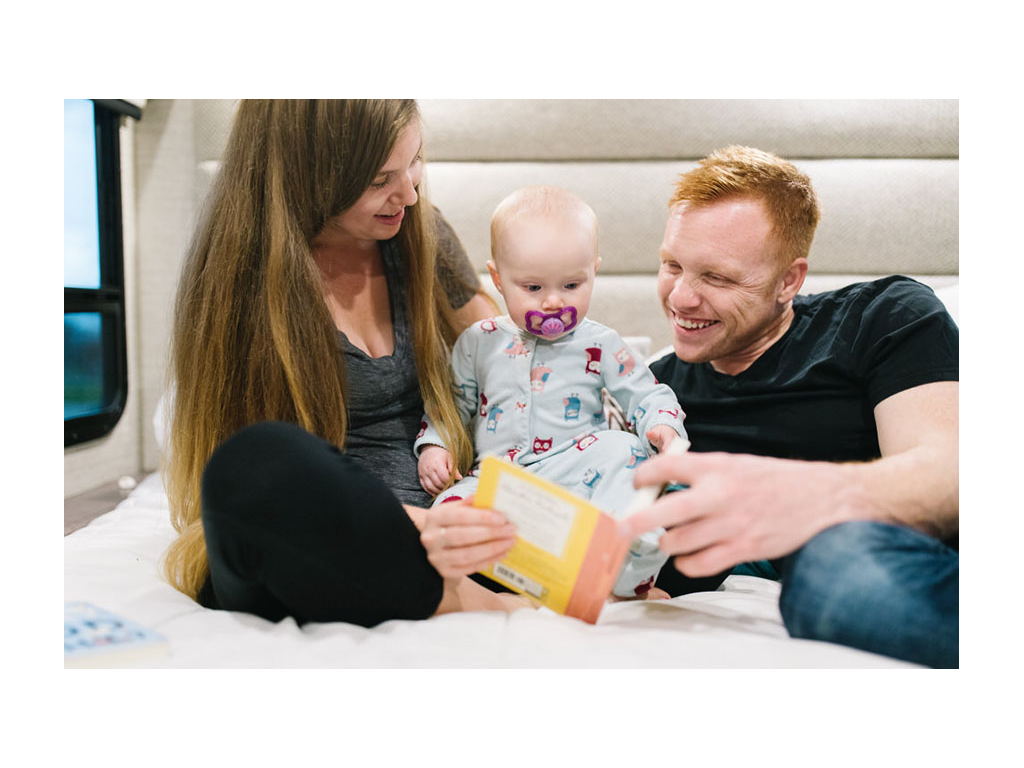
13. Use an iPhone app instead of bringing a white noise machine.
Parents will do anything to make sure we don’t wake up the baby during nap time. In a house, this means a white noise machine, but often that’s just one more thing to pack (or forget to pack).
We use the Box Fan Rest Sounds app on our phones instead. There are tons of free apps like this in the App Store. We put a phone on the Connexx chargers built into the bedside of our Winnebago, so it won’t die and turn on Do Not Disturb. Then we are free to cook, visit with friends, have video calls with clients, or watch a movie in the front of our RV without waking up Ellie.
14. Keep a changing pad, wipes, and hand sanitizer on hand at all times.
I was cooking dinner with The Office on in the background while Heath played on the floor with Ellie. She had just started to crawl and Heath loved playing on the floor with her. Until I heard, “Oh my God. Oh NO! Crap, crap, crap. Alyssa!!!!”
And there on the floor, was a pile of poop. Fresh and getting smeared everywhere as Ellie with a half-on diaper kept playing, oblivious to the chaos in her wake.
I can’t be too sure as to what went wrong, but I know you’ll want to keep a changing pad, wipes, hand sanitizer, and cleaning supplies within arm’s reach at all times. Heath is still emotionally scarred from that experience and will NOT change Ellie without that changing pad handy.
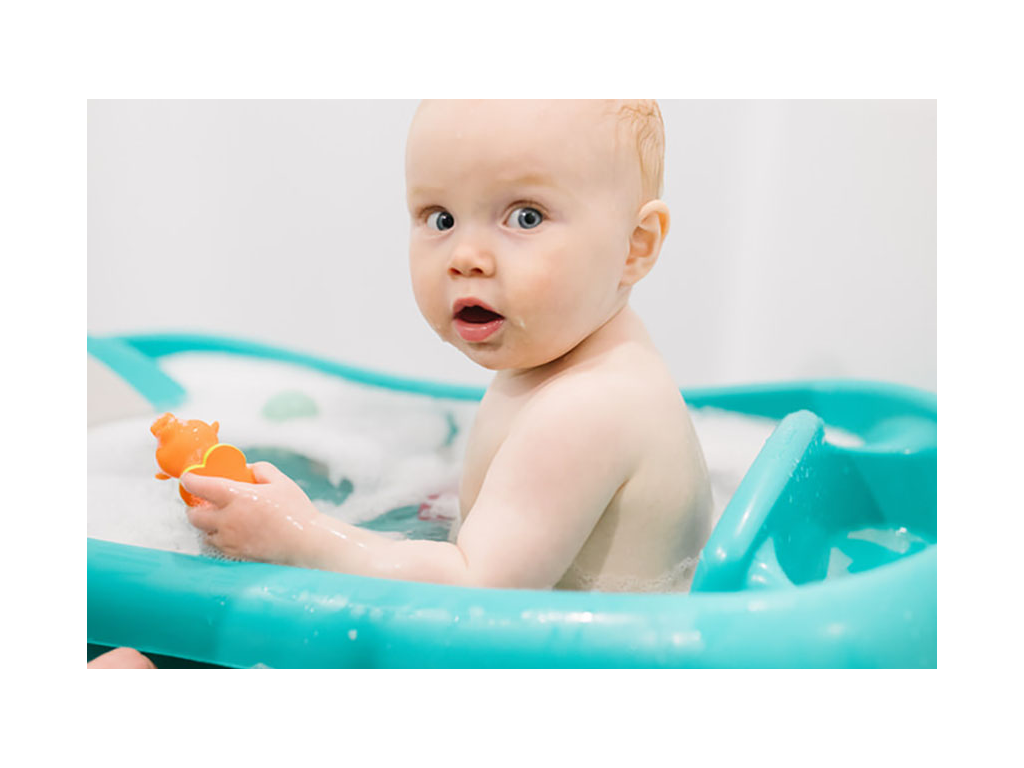
15. Baby proof the RV.
One of the best things about RVs is that they are pretty much baby proof. All the doors latch closed because the last thing you need while driving down the road is for a jar of salsa to fly out of the fridge. So as long as I close the drawers, I don’t have to worry about Ellie getting into any knives or breakables.
Plus, with our Forza, there is a stair cover. This feat of engineering is the only reason I can blink without worrying that my child has sprinted toward the stairs again. This is life-saving once babies are mobile (usually around 6-7 months).
The only thing that isn’t baby proofed is the parking brake and Ellie loves to crawl into the driver’s seat and press all the buttons! So far, she hasn’t done anything bad—except sit on the horn a few times scaring our neighbors—but it worries me that she’ll mess up something on the rig up there. But if we swivel the driver’s seat around and scoot it all the way back, it blocks her access to all the tempting buttons.
Living and traveling in such a small space with a baby can be challenging at times, but it’s always worth it. Our Forza is where Ellie started crawling for the first time and where she took her first steps. It’s our home on wheels and a chance for Ellie to see and experience the outdoors, to stick her toes in the sand at the ocean, to hike with mountain views, and to pet every single dog at every single campground we visit. (That’s probably her real favorite part of RV life.)
RVing with a baby is my favorite way to travel. She always sleeps in the same bed, comes home to a familiar warm place, and we have the freedom to go anywhere. Well, almost anywhere.
Comments
Comments on this post are moderated, so they will not appear instantly. All relevant questions and helpful notes are welcome! If you have a service inquiry or question related to your RV, please reach out to the customer care team directly using the phone numbers or contact form on this page .